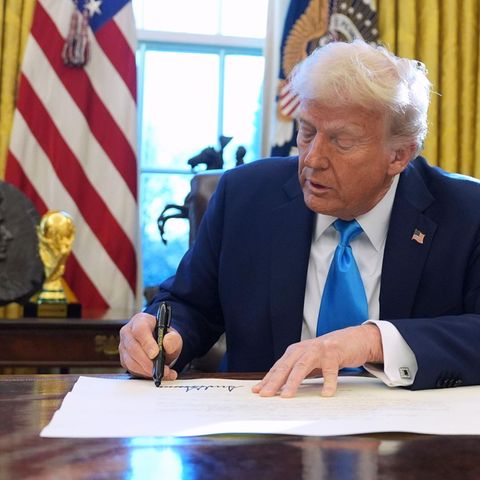The journey of the yellow metal not only arouses greed but also some fears. What is behind such a rise? That is why analysts are now wondering if it is time to maintain positions, or if it is time to turn around, or better to double the bet.
It doesn’t seem to be news anymore, but Gold did it again, it marked another milestone: its 48th all-time high in 2025, reaching US$4,176 per ounce. To measure the recent rally in the precious metal, it is worth noting that the move from US$3,500 to US$4,000 took only 36 days. For experts in the global metals market, the increase has been driven by strong investment demand amid geopolitical tensions, the weakness of the dollar, the reduction of expectations from the Federal Reserve (Fed) and the risks of the stock and bond markets.
The content you want to access is exclusive to subscribers.
Apparently today everyone is buying, not only central banks, ETF funds, but even large investors, and even retailers began to bet on the precious metal. As an experienced global gold market operator pointed out, it is possible that the “bubble” will not deflate until a strong seller appears, which does not imply that if the metal is very overbought a correction will occur. But Looking to the horizon, experts highlight that stocks are nervous in October due to expanding excesses and gold is likely to remain a good hedge despite its spectacular rise. While gold allocation models suggest that political tension, strong options market activity and currency weakness played a major role in gold’s performance last month, they also reflect that the only drag came from rebalancing and profit taking and the intraday dip on September 30, which was quickly bought.


It is known that the month of October is known for large stock sell-offs and the risks are quite high. Gold is generally a good hedge, but there may be concerns about its responsiveness given how superb it appears to be. Besides, a very oversold dollar continues to represent a threat to gold, if a restriction materializes. However, the models indicate that these concerns are not justified and that, in the absence of a liquidity crisis, gold’s hedging credentials remain intact. Since September is, on average, the worst calendar month for U.S. stocks and October is known for its big corrections, it makes it a generally nervous time for stock investors.
Does gold have fuel left in the tank?
Likely threat to stocks is acutegiven lofty valuations, idealistic earnings projections, high market concentration, extended positioning, and technical red flags. In that context, gold looks like a suitable long-term diversifier and a good short-term hedge against stock declines, however, since gold is not a contractual hedge, good performance during stock corrections is not guaranteed. Besides, There are concerns that gold will not respond as easily to a decline in stocksmainly because it appears overbought, and from a tactical perspective, the metal could struggle to find marginal buyers in this scenario, even if long-term strategic positioning remains weak. That being said, does gold have any fuel left in the tank?
Here the bipolarity of the analysts arises, those who see an end to the cycle and those who bet on the trend. In other words, hold, sell or buy? But, perhaps, the most relevant thing is to pose the dilemma from another perspective: Isn’t gold the “canary in the coal mine”? Some, like Alberto Cárdenas of the CEIF, maintain that the price reached by gold reflects a level of overbought not seen since 1980 and remember that the last time gold was at these overbought levels, the recession was imminent. They explain that the previous time was in April 1973, 8 months ahead of the recession and the S&P500 index fell more than 40% in the following months. So they say that Beyond inflation hedging or recession protection, there is a story of geopolitical risk developing not seen in at least 50 years.
It should be noted that both gold and the US Treasury bond market have been reflecting the growing global discontent with the economic policies of the Trump administration and, as Desmond Lachman of the AEI stated days ago, a financial crisis is likely to occur before a policy change. In that sense, Lachman, a survivor of the legendary Wall Street investment bank Salomon Smith Barney and a former IMF official, warned that just as miners use canaries to give an early warning signal that something is wrong in a coal mine, so too The meteoric rise in the price of gold since the start of the Trump administration could be signaling real trouble ahead in the dollar and bond markets. In the view of this world expert, the Trump administration would do well to heed these warnings and soon correct the course of its policy to regain market confidence, because otherwise, it would have to prepare for real turbulence in the financial markets on the eve of next year’s midterm elections. For Lachman, the rebound in the price of gold in 2025 is “spectacular”, surpassing all other major financial assets.
What is seen behind the gold boom?
What does Lachman see behind the gold boom? For him, One of the main reasons for the rise in the price of gold is the fear that the US will try to free itself from its enormous public debt by liquefying it via inflation. He believes that this fear seems to be well founded since the Trump Tax Cuts Act, already enacted, has taken the country’s public finances down a clearly unsustainable path. According to the Congressional Budget Office, such a law will keep the budget deficit above 6.5% as far as the eye can see, causing public debt to rise to a Greek-like 128% of GDP by 2034. But another reason many now believe the current administration will try to reduce public debt through inflation is Trump’s continued attacks on the Fed’s independence: at a time when the inflation remains above the Fed’s 2% target and Trump’s import tariffs are expected to increase inflation, the Republican leader is putting considerable pressure on Fed Chair Jerome Powell to reduce interest rates by two to three percentage points, and also He is doing everything he can to fill the Fed Board with monetary policy pacifists and appoint a replacement for Powell to do his bidding to slash interest rates.
Also consider that The current tendency of central banks to move away from the dollar and towards gold in their reserves is another factor that plays in this chess. Lachman explains that this appears to be done due to its growing distrust of the US as a reliable financial partner, since, in recent years, the US has used the dollar as a weapon in its conflict with countries such as Iran and Russia, raising fears that this practice could be used against other countries. Likewise, he believes central banks appear unsettled by Trump’s arbitrary imposition of punitive tariffs on allies and enemies alike, as well as his apparent disregard for the rule of law.
Of course, he also pointed out that Gold is not the only financial asset that is sounding the alarm that US economic policy may be “out of control.” since since the beginning of the year, The dollar has lost around 10% of its value when it was expected to be boosted by the highest import tariffs in a century and the widening of the short-term interest rate differential in favor of the US. The same goes for the bond market which seems to have lost its safe haven status.as investors no longer seem to flock to the US Treasury market in times of turbulence.
As an old acquaintance from Argentina, MIT economist Rudi Dornbusch, used to say, financial crises take much longer to occur than was thought possible, however, when they do occur, they do so at a much greater speed than would have been predicted. Lachman argues that with clear early signs that investors are losing confidence in the U.S. economy coming from the gold and dollar markets, the Trump administration would do well to reconsider its economic approach.
Source: Ambito
I am a 24-year-old writer and journalist who has been working in the news industry for the past two years. I write primarily about market news, so if you’re looking for insights into what’s going on in the stock market or economic indicators, you’ve come to the right place. I also dabble in writing articles on lifestyle trends and pop culture news.




